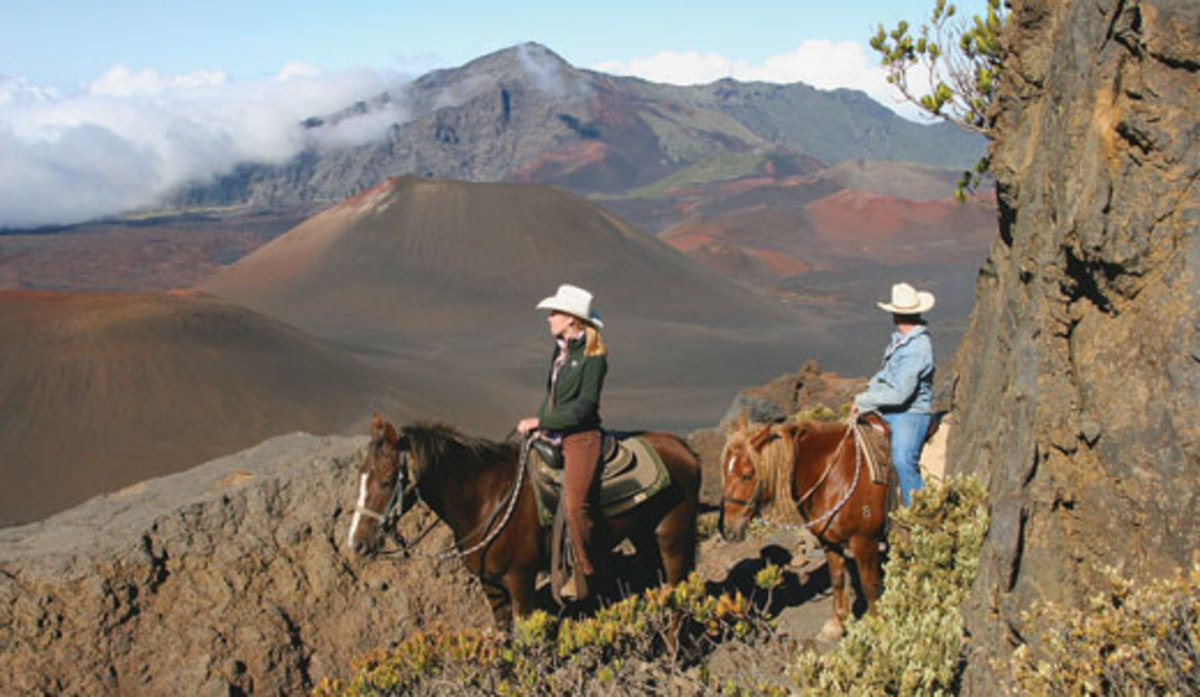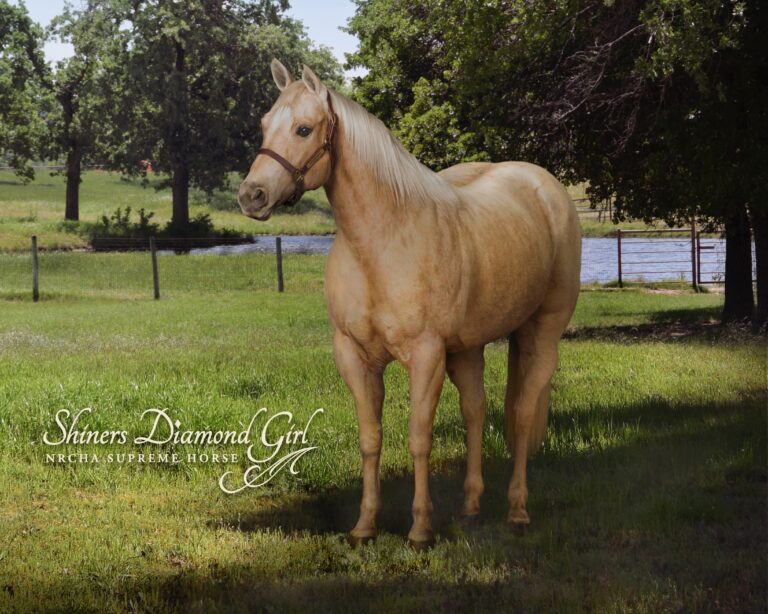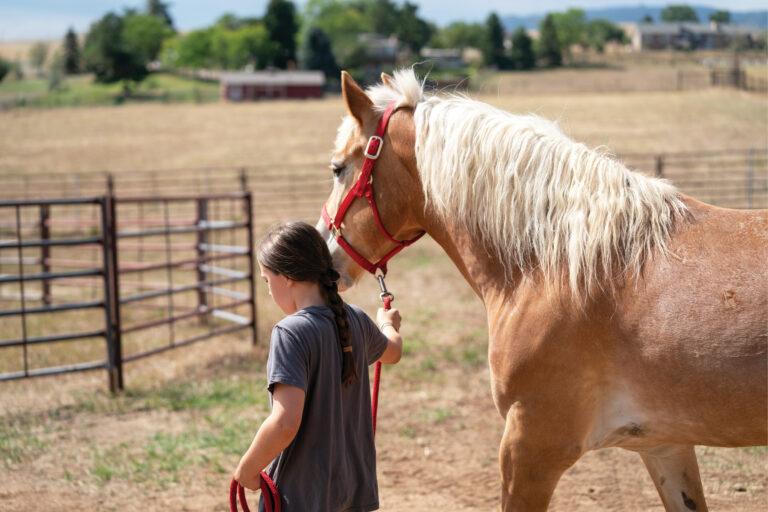Darley Newman is going places and – via her PBS show, Equitrekking – she wants you to go places, too. In 2007, her first season of shows featured Newman riding on historic ranches in Wyoming, exploring the Wilderness Trails Ranch in Colorado and Green Mountain trails in Vermont, and beach riding on Georgia’s Sea Island. She also enjoyed far-flung adventures in Ireland and Spain.

“Our first broadcasts were on a small satellite network and primetime on PBS in New Mexico, and did well,” she says. “Today, we’re on 70 percent of PBS stations – and growing! Our new, 2008 season begins in January.”
Newman grew up in South Carolina with cats and, for a while, a trusty dog named Bosley, who sometimes found himself carrying an imaginative, horse-crazy little girl on his back. But it was the horses at summer camp that solidified her abiding interest in all things equine.

Later, working in radio and television in the fast-paced environments of Washington, D.C. and New York, Newman mused on how to combine her technical knowledge with her dual passions for travel and horses. The concept of Equitrekking, a show that travels the world by horseback, was a natural evolution.
“I travel to wonderful places, meet interesting people, and ride fantastic horses,” she says. “It’s exciting to learn about a location’s culture and history through its horses. I might start the day riding with strangers on strange horses, but, by the end of the day, we’re all friends. That’s true everywhere around the world.”
Read on to meet Darley Newman, an adventurous trailblazer with her eyes on the horizon.
TTR: Growing up in South Carolina, when did you first become aware of horses?
Newman: When I was 7 years old, I went to my first summer camp in North Carolina. I took riding lessons and explored cool mountain trails on horseback. I wasn’t lucky enough to have access to horses at home, so that summer camp, and many to follow, were an awakening and led me to seek out horses in my adult life.
TTR: Tell us about your first ride.
Newman: It was at Camp Ton-a-Wanda outside of Hendersonville, in the mountains of North Carolina. The ride, walking around a ring, wasn’t spectacular, but the feeling of awe was. Horses seemed massive then – and sometimes still do today. Would they really let me ride them? I watched the older riders and wanted to ride like them. I knew it would be a challenge. Those first rides made me want to ride faster and better, and to understand horses more. I’ve been in awe of horses ever since.
TTR: Do you own a horse today?
Newman: No. Then and now, I ride many different horses. Growing up, I lived with my mom in a townhouse in Myrtle Beach, South Carolina, and I was lucky to have cats. The cats were not rideable.
TTR: How do you hone your riding skills and gain trail savvy?
Newman: I take lessons and trail ride with a group of friends. I used to ride at a stable in Connecticut, where my favorite mount was Roxy, a tall, very special Thoroughbred. A former three-day-eventing horse, Roxy was sweet, versatile, and great on trails. As all horses do, Roxy taught me a lot about riding and about myself. Someday, I’ll have a horse of my own, but for now lessons, and traveling and riding for my Equi-trekking show, are the next best thing.
TTR: How do you select your Equitrekking destinations?
Newman: I’ve always dreamt of exploring exotic destinations by horseback. When I research locales, fellow riders and travelers are my best resource for firsthand information, and I love to hear where they dream of riding.
I work with tourism boards to obtain suggestions and contacts on the ground. There are many details to consider, from weather to the unique horse breeds we might feature. I’d previously ridden some places, like the Biltmore Estate in Asheville, North Carolina, that were featured in our first season. At the Biltmore, you ride the same historic trails that guests of George Vanderbilt traveled during the Gilded Age.
TTR: What’s absolutely essential?
Newman: It’s very important that the horses are well-loved and well-cared for, and the operators have a passion for both their horses and their business. Running a small business generally turns out to be a way of life, so it’s important they love what they’re doing. Touring a place with people who love it is very, very special.
TTR: Despite your thorough planning, are there still surprises on your Equitrekking rides?
Newman: Every ride holds some surprise. On the Big Island of Hawaii, it was the incredibly vocal Hawaiian horses in the Waipi’o Valley. At the Na’alapa Stables, which is owned by people who were born in the valley, there are native Hawaiian Horses, from herds that run wild in the valley.
Maile of Na’alapa Stables grew up in the valley and trained a few of these horses for trail rides. On our ride, my horse, Midget, didn’t like to be separated from the other horses, even for a moment. If I left the trail to smell a flower growing on a tree, or pick an avocado or star fruit, Midget would whinny so loudly that I shook in the saddle. Hawaiian Horses, like most horses, dislike being separated from their friends! They are true survivors in this valley.

TTR: That sounds like an amazing ride.
Newman: It was! Riding through the lush Waipi’o Valley, we were surrounded by 2,000-foot cliffs lined in waterfalls. Many beloved Hawaiian rulers spent time in Waipi’o Valley and are buried in the valley walls, earning it the designation, “Valley of the Kings.” It is a wild and interesting place to explore on horseback – definitely best with a local guide.

TTR: What’s the most exotic place you’ve ridden in?
Newman: There are many, but riding into Haleakala Crater on Maui was totally exotic. Where else can you ride into the crater of a volcano? Hearing the rusty red and black volcanic cinders crunching under your horse’s hooves on the Sliding Sands Trail is bizarre and humbling, especially when you look out to a vast expanse of cinder cones and the remnants of lava flows on the crater floor.
The going is strenuous, and the horses must be very fit. Clouds roll in and out, and the elevation drops 2,500 feet as you descend into the crater. As the sun travels across the sky, colors and features that you hadn’t noticed before are illuminated. It was an incredible, otherworldly ride – definitely best on horseback.
TTR: Tell us about the most unforgettable horses you’ve ridden.
Newman: I rode an exquisite white Andalusian horse named Figo on the beaches of Southern Spain and through the trails of Donana National Park. The Queen of Spain rides Figo when she visits the park. Although it was my first time riding him, he listened to my subtle cues like we were old friends. Wonderful!?
In Ireland, I rode a 12-year-old Irish Cob named Jesse through the Ravensdale Forest on the Cooley Peninsula. Jesse was not only beautiful, he was also agile, willing, sweet, and had an ultra-smooth canter. We rode along a turf cutters’ road to an ancient stone circle and climbed to a spot with panoramic views of the medieval town of Carlingford and the dramatic Mourne Mountains. Jesse was the perfect, patient trail horse while we were filming. I wanted to bring him home! I’d go back to Ravensdale just to ride Jesse.
TTR: What’s the most challenging trail ride you’ve been on?
Newman: The trail to Engineer Mountain in Colorado’s San Juan National Forest. It was August, but the chilly temperatures and large hailstones beating down on my cowboy hat made it feel like the winter. Coming from the southern East Coast, I’m not used to hailstorms in August!
At one point, a large tree obstructed the narrow trail where the mountain fell away in a steep, wooded freefall. The other side was bounded by a wall of rocks and dirt. Cinnamon, a Paint Horse owned and trained by my guide, Anne Rapp, took great care of me, but it was still harrowing. After passing by the tree, the trail immediately took a sharp turn. With no room to turn around or go back if we met other travelers, Anne called out to make sure that riders around the corner knew that we were coming.
I didn’t dare look down into the chasm, but tried to keep Cinnamon from crushing my leg against the tree while she concentrated on staying on the mountain. After the hailstorm, the rocky trails were slick, icy, and extremely challenging.
TTR: What’s the most humorous thing that’s happened while filming?
Newman: In Iceland, I went on a horse drive with some Icelandic farmers. I don’t know who was more wild and spirited – the farmers or their horses! Ten of us drove 50 horses to a giant waterfall. It was only my third time on an Icelandic horse, and I wasn’t sure that I was ready to be moving a herd over roads, lava fields, and bumpy, treacherous terrain on the way to Gullfloss, Iceland’s Golden Waterfalls.
I tölted quickly, joining Asa, an exuberant blond farmer, in the lead. The tölt is a special Icelandic gait, a running walk that feels like gliding on horseback. At first, my horse broke into a trot, and I bounced quite a bit. I noticed that everyone else was tölting, so I cued my Icelandic to tölt.
When we left the trail to ride through lava fields and over treacherous terrain, we couldn’t slow down, because the herd behind us was on its way. Asa turned to me and said, “Go fast!” The look on my face said it all to our film crew, as I turned into the wilderness and attempted to “go fast!”
It was quite a rush.
The hardy Icelandic Horses have been traveling this challenging terrain for centuries and do it well. Honestly, I was astounded that I got through the horse drive, and even more amazed when I learned that they do it once a week!
TTR: What are some of your favorite seasonal riding destinations?
Newman: In autumn, I like riding trails in Connecticut and seeing the brilliant changing colors of the leaves. Trails are shaded and varied, and there are good places for a canter or gallop and some nice jumps in the woods. Winter is great there, too, after a light, powdery snow.
In summer, I go anywhere cool. Colorado and Wyoming are favorites, because the terrain is stunning, the land is vast, and the weather is cool. Out West, I feel uninhibited riding, like a bold adventurer.
TTR: How can viewers best apply what they see on your show to their own rides?
Newman: Dream big. Start small, but start. You can do it!
TTR: What’s your best tip for riding distant trails on strange horses?
Newman: Assess your riding ability honestly. Having the appropriate horse for your abilities, personality, height, and weight is absolutely necessary. Once on the trail, remain aware of yourself, your horse, and what’s going on around you.
TTR: What adventures should we look for in your second season?
Newman: You’ll love the second season! There are adventures in Iceland, like the horse drive and a ride through a section of volcanic pseudocraters with Diddi, one of Iceland’s top riders. The two Irish episodes are wonderful. I loved riding on the rarely visited Cooley Peninsula, beach riding in Donegal, and riding to the mystical Omey Island about as far west as you can travel in Ireland. We also rode at the beautiful and historic Mount Juliet Estate and on trails through boglands in County Clare.
Closer to home, in Virginia, you’ll see a steeplechase, a polo lesson, and Western-style trail riding at Marriott Ranch (not your typical Marriott). We interviewed Civil War reenactors and rode through Civil War battlefields at the Inn at Kelly’s Ford.
Then there’s California Wine Country – aah! Riding in Sugarloaf Ridge State Park, with views of Napa and Sonoma Valley at sunset was adventurous and absolutely beautiful. We rode on Northern California’s dramatic beaches, among the Redwoods with a naturalist, through a family-owned vineyard, and at the site of the old Sonoma Rodeo.
We ride on Hawaii’s Big Island, in the remote Valley of the Kings, at Kahua Ranch in cowboy country, and at the historic Parker Ranch. On Maui, viewers ride with us into Haleakala Crater, with native Hawaiians in Kipahulu to a stunning rainforest waterfall, on a sunset ride in the West Maui Mountains, and with sixth generation ranchers at Pi’iholo Ranch by the western town of Makawao.
TTR: What three qualities do you value in a trail horse?
Newman: Experience, a calm, sensible disposition, and a fast walk.
TTR: What three qualities do you value in a friend?
Newman: Trustworthiness, a kind heart, and a good sense of humor.
TTR: What’s the best book you’ve read recently?
Newman: A Good Horse Has No Color: Searching Iceland for the Perfect Horse, by Nancy Marie Brown. It’s about an American woman who goes to Iceland to find a horse. The book takes you into the homes of Icelandic farmers and breeders, and gives wonderful insight into Icelandic culture, with its strong ties to horses and nature. A good read!
TTR: What’s your most valued possession?
Newman: Kiki, my cat, though she wouldn’t call herself my possession. Kiki is fluffy and black, with beautiful green eyes and a splash of white on her chest, and I brag about her constantly. She’s very sweet, and I love her dearly.
TTR: Complete this sentence: People would be surprised to know that I…
Newman: …..lived in New York City for five years. Growing up in South Carolina, I always wanted to experience the fast-paced vibe of the Big Apple and working in television, and it was great.
TTR: If you could invite three people from any era to tell stories around a campfire, who would you chose?
Newman: Johnny Cash, for his music; Mark Twain for his wit and his stories; and Theodore Roosevelt, because he was an explorer, naturalist, and conservationist.
TTR: What is your idea of perfect happiness?
Newman: Living life to its fullest, and taking advantage of every single day.






